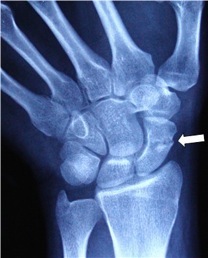 The eight bones in the wrist are arranged into a “proximal row,” furthest from the fingers, and a “distal row,” closest to the fingers. The scaphoid, which technically is in the proximal row, is the most commonly broken bone of those eight in the wrist.
The eight bones in the wrist are arranged into a “proximal row,” furthest from the fingers, and a “distal row,” closest to the fingers. The scaphoid, which technically is in the proximal row, is the most commonly broken bone of those eight in the wrist.
Scaphoid fractures result from a fall onto your outstretched hand. You might have pain, swelling, and/or bruising. This commonly is misdiagnosed as a “sprain” and unfortunately sometimes not discovered until long after the injury.
X-rays might or might not show the fracture. If you have a lot of tenderness at the “snuffbox” (a divet like spot at the base of the thumb side of the wrist), there might be a scaphoid fracture and you should be placed in a splint and reevaluated in a few weeks. An MRI also can be used to see whether there is a fracture or not very early if needed.
If the bones on either side of the break are in the right place, you might be treated in a cast. In some cases, your doctor might suggest putting a screw across the fracture in surgery. Because of a relatively bad blood supply, this bone has difficulty healing, particularly if broken at certain places in the bone. Healing can take two months or longer.
If you have a scaphoid fracture that is not treated, it likely will not heal. Over time, the non-united (unhealed) scaphoid falls into a bad position and the wrist bones cannot move correctly. Significant arthritis with pain can result.
Even with proper treatment, you might develop “avascular necrosis” of part of the bone, which is when part of the bone dies because of loss of blood supply.
If you had a fall onto your wrist with bruising, swelling, or pain but normal X-rays, it is worthwhile to see a hand specialist to see if there is an injury that could not be seen at first.